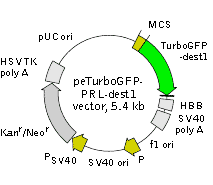
|
||||||||||
|
||||||||||

|
|
||||||||||||||||||||||||||||||||||||||||||||||||||||||||||||||||||||||||||||||||||||||||||||||||||||||||||||||||||||||||||||||||||||||||||||||
The vector sequence has been compiled using the information from sequence databases, published literature, and other sources, together with partial sequences obtained by Evrogen. This vector has not been completely sequenced. |
|||||||||||||||||||||||||||||||||||||||||||||||||
 Download
|
| ||||||||||||||||||||||||||||||||||||||||||||||||
| Bgl II* | Sac I | EcoR I* | Sal I | Sac II | Sma I/Xma I | Age I | TurboGFP-dest1 | ||||||||||||||||||||||
| Afe I | Xho I* | Hind III | Pst I* | Kpn I | Apa I* | BamH I* | Nco I* | ||||||||||||||||||||||
| ... | A.GCG.CT | A.CCG.GAC.TC | A.GAT. | CT | C. | GAG | .CTC | . | AAG.CTT | .C | GA.ATT. | C | TG.CA | G | .TCG.AC | G.GTA. | CC | G.C | GG | .G | CC.C | G | G.G | AT.CC | A.CCG.GT | C.GCC.A | CC. | ATG.G | ... |
* – not unique site.
Vector description
peTurboGFP-PRL-dest1 is a promoterless vector encoding destabilized variant of the green fluorescent protein TurboGFP, which can be used as in vivo reporter of promoter activity (see reporter description). To generate TurboGFP-dest1 variant, residues 422-461 of mouse ornithine decarboxylase (MODC) were fused to the TurboGFP C-terminus. This MODC region contains a PEST amino acid sequence that targets the protein for degradation and provides for rapid protein turnover [Li et al., 1998]. TurboGFP-dest1 retains fluorescent properties of the native protein and has a half-life of approximately 1-1.5 hours, as measured by fluorescence intensity of cells treated with the protein synthesis inhibitor, cycloheximide. Rapid TurboGFP-dest1 turnover allows accurate analysis of changes in gene regulation.
TurboGFP-dest1 codon usage is optimized for high expression in mammalian cells (humanized) [Haas et al., 1996]. To increase mRNA translation efficiency, Kozak consensus translation initiation site is generated upstream of the TurboGFP-dest1 coding sequence [Kozak, 1987]. Fragments of exons 2 and 3 and intron 2 of human beta globin gene are added in the 3’ UTR of TurboGFP-dest1 coding sequence in order to increase the protein expression level.
Multiple cloning site (MCS) is located upstream of the Kozak consensus translation initiation site and can be used to clone a promoter or a promoter/enchancer combination of interest. Without the addition of a functional promoter, this vector will not express TurboGFP-dest1.
The vector backbone contains SV40 origin for replication in mammalian cells expressing SV40 T-antigen, pUC origin of replication for propagation in
SV40 early promoter (PSV40) provides neomycin resistance gene (Neor) expression to select stably transfected eukaryotic cells using G418. Bacterial promoter (P) provides kanamycin resistance gene expression (Kanr) in
Note: The plasmid DNA was isolated from dam+-methylated
Propagation in
Suitable host strains for propagation in
Location of features
MCS: 12-89
TurboGFP-dest1
Kozak consensus translation initiation site: 90-100
Start codon (ATG): 97-99
Last amino acid in TurboGFP: 790-792
Amino acid residues of mouse ornithine decarboxylase (MODC) PEST sequence: 808-930
Stop codon: 928-930
Fragment of human beta globin (HBB) gene
Last 35 bp of HBB exon 2: 939-973
HBB intron 2: 974-1823
First 233 bp of HBB exon 3: 1824-2057
SV40 early mRNA polyadenylation signal
Polyadenylation signals: 2199-2204 & 2228-2233
mRNA 3' ends: 2237 & 2249
f1 single-strand DNA origin: 2296-2751
Bacterial promoter for expression of Kanr gene
-35 region: 2813-2818
-10 region: 2836-2841
Transcription start point: 2848
SV40 origin of replication: 3092-3227
SV40 early promoter
Enhancer (72-bp tandem repeats): 2925-2996 & 2997-3068
21-bp repeats: 3072-3092, 3093-3113 & 3115-3135
Early promoter element: 3148-3154
Major transcription start points: 3144, 3182, 3188 & 3193
Kanamycin/neomycin resistance gene
Neomycin phosphotransferase coding sequences:
Start codon (ATG): 3276-3278
Stop codon: 4068-4070
G->A mutation to remove Pst I site: 3458
C->A (Arg to Ser) mutation to remove BssH II site: 3804
Herpes simplex virus (HSV) thymidine kinase (TK) polyadenylation signal
Polyadenylation signals: 4306-4311 & 4319-4324
pUC plasmid replication origin: 4655-5298
References:
- Haas J, Park EC, Seed B. Codon usage limitation in the expression of HIV-1 envelope glycoprotein. Curr Biol. 1996; 6 (3):315-24. / pmid: 8805248
- Kozak M. An analysis of 5'-noncoding sequences from 699 vertebrate messenger RNAs. Nucleic Acids Res. 1987; 15 (20):8125-48. / pmid: 3313277
- Li X, Zhao X, Fang Y, Jiang X, Duong T, Fan C, Huang CC, Kain SR. Generation of destabilized green fluorescent protein as a transcription reporter. J Biol Chem. 1998; 273 (52):34970-5. / pmid: 9857028
Notice to Purchaser:
TurboGFP-related materials (also referred to as "Products") are intended for research use only. The Products are covered by U.S. Pat. 7,678,893; European Pat. 1576157; and other Evrogen Patents and/or Patent applications pending. By use of these Products, you accept the terms and conditions of the applicable Limited Use Label License.
|
Copyright 2002-2023 Evrogen. All rights reserved. Evrogen JSC, 16/10 Miklukho-Maklaya str., Moscow, Russia, Tel +7(495)988-4084, Fax +7(495)988-4085, e-mail:evrogen@evrogen.com |


